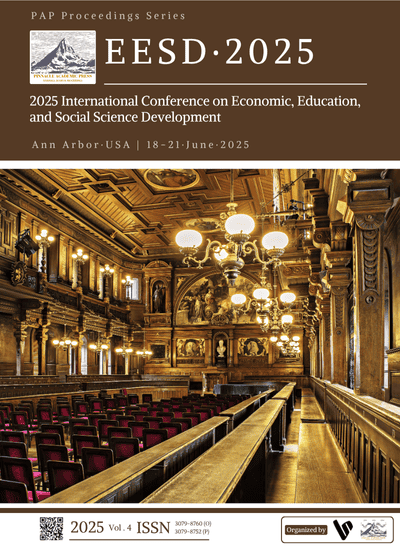Evaluating Ecological Resilience in the Yangtze River Economic Belt in China: A PSR Model-Based Spatiotemporal Analysis (2008-2018)
DOI:
https://doi.org/10.71222/j5nfjh48Keywords:
Yangtze River Economic Belt (YREB), ecological resilience, PSR model, indicator system, regional assessmentAbstract
The assessment of ecological resilience holds significant theoretical importance for the high-quality development of the Yangtze River Economic Belt (YREB). This study constructs an ecological resilience evaluation system based on the Pressure-State-Response (PSR) model by selecting pressure, state, and response indicators. It investigates the spatiotemporal evolution of ecological resilience in the YREB from 2008 to 2018, regional disparities, and their underlying causes. The results indicate that: (1) The overall ecological resilience of the YREB exhibited a fluctuating upward trend during 2008-2018. (2) Distinct regional drivers were identified: ecological resilience in the upstream regions correlated strongly with response indicators, midstream regions showed closer ties to pressure indicators, and downstream regions demonstrated interdependencies between resilience and both state and response indicators. Specifically, fluctuations in the response index reflect the intensity of investment, variations in the pressure index indicate the pace of urbanization processes, and changes in the state index correspond to the dynamics of water resource conditions. This research provides a scientific foundation for ecological conservation and sustainable development in the YREB, elucidates the impact of human activities on ecological environments, and offers strategic insights for achieving high-quality development under the "Yangtze River Protection" framework.
References
1. D. Li and J. Zhang, "Measurement and analysis of ecological pressure due to industrial development in the Yangtze River economic belt from 2010 to 2018," J. Clean. Prod., vol. 353, p. 131614, 2022, doi: 10.1016/j.jclepro.2022.131614.
2. J. Wang et al., "Fighting against the battle of protection and restoration of the Yangtze River Basin to start a new chapter of ecological-oriented and green development," J. Environ. Eng. Technol., vol. 12, no. 2, pp. 329–335, 2022.
3. H. Li, Q. Yang, and Y. Zhao, "Focusing on water eco-environment problems and sustainably promoting ecological conserva-tion and restoration of the Yangtze River," J. Environ. Eng. Technol., vol. 12, no. 2, pp. 336–347, 2022.
4. Y. Huang and J. Wu, "Spatial and temporal driving mechanisms of ecosystem service trade-off/synergy in national key urban agglomerations: A case study of the Yangtze River Delta urban agglomeration in China," Ecol. Indic., vol. 154, p. 110800, 2023, doi: 10.1016/j.ecolind.2023.110800.
5. R. Yao et al., "Mechanism and measurement of the effects of industrial agglomeration on agricultural economic resilience," Agriculture, vol. 14, no. 3, p. 337, 2024, doi: 10.3390/agriculture14030337.
6. S. Lu et al., "The assessment of forest ecological security and its determining indicators: A case study of the Yangtze River Economic Belt in China," J. Environ. Manage., vol. 258, p. 110048, 2020, doi: 10.1016/j.jenvman.2019.110048.
7. Y. Yao and Y. Yang, "Spatiotemporal effects of landscape structure on the trade-offs and synergies among ecosystem service functions in Yangtze River Economic Belt, China," Sci. Rep., vol. 15, no. 1, pp. 1–25, 2025, doi: 10.1038/s41598-025-99295-z.
8. Q. Zhang, T. Huang, and S. Xu, "Assessment of urban ecological resilience based on PSR framework in the Pearl River Delta urban agglomeration, China," Land, vol. 12, no. 5, p. 1089, 2023, doi: 10.3390/land12051089.
9. W. Qun et al., "Toward a sustainable agricultural system in China: exploring the nexus between agricultural science and technology innovation, agricultural resilience and fiscal policies supporting agriculture," Front. Sustain. Food Syst., vol. 8, p. 1390014, 2024, doi: 10.3389/fsufs.2024.1390014.
10. P. Ran et al., "Exploring changes in landscape ecological risk in the Yangtze River Economic Belt from a spatiotemporal per-spective," Ecol. Indic., vol. 137, p. 108744, 2022, doi: 10.1016/j.ecolind.2022.108744.
11. H. Wang et al., "Land use change and its impact on ecological risk in the Huaihe River Eco-Economic Belt," Land, vol. 12, no. 6, p. 1247, 2023, doi: 10.3390/land12061247.
12. Z. Tai et al., "Identification of spatial distribution of afforestation, reforestation, and deforestation and their impacts on local land surface temperature in Yangtze River Delta and Pearl River Delta urban agglomerations of China," Remote Sens., vol. 16, no. 18, p. 3528, 2024, doi: 10.3390/rs16183528.
13. H. Guo et al., "Rural households' willingness to participate in the Grain for Green program again: a case study of Zhungeer, China," For. Policy Econ., vol. 44, pp. 42–49, 2014, doi: 10.1016/j.forpol.2014.05.002.
14. P. Zhao et al., "Fuzzy evaluation of low carbon development levels for logistic enterprises in China," J. Ind. Eng. Manag., vol. 8, no. 5, pp. 1698–1710, 2015, doi: 10.3926/jiem.1626.
15. M. Liu and J. Xi, "Multi-objective optimization of the spatial structure and layout of the protected area based on ecosystem services: A case study of the Yellow River’s headwaters region in the three-river-source national park," Chin. J. Urban Environ. Stud., vol. 9, no. 3, p. 2150016, 2021, doi: 10.1142/S2345748121500160.
16. B. Zhou et al., "Improvement of environmental performance and optimization of industrial structure of the Yangtze River economic belt in China: going forward together or restraining each other?," J. Chin. Gov., vol. 6, no. 3, pp. 435–455, 2021, doi: 10.1080/23812346.2021.1888472.
17. Y. Wang et al., "Spatial temporal patterns and driving factors of industrial pollution and structures in the Yangtze River Eco-nomic Belt," Chemosphere, vol. 303, p. 134996, 2022, doi: 10.1016/j.chemosphere.2022.134996.
18. Y. Ren, Y. Tian, and X. Xiao, "Spatial effects of transportation infrastructure on the development of urban agglomeration in-tegration: Evidence from the Yangtze River Economic Belt," J. Transp. Geogr., vol. 104, p. 103431, 2022, doi: 10.1016/j.jtrangeo.2022.103431.
19. Y. Zhen, D. Shi, and Y. Lu, "The impact of regional integration strategies on the formation of city regions and its agglomeration shadow: evidence from the Yangtze River Delta, China," Land, vol. 12, no. 5, p. 1053, 2023, doi: 10.3390/land12051053.
20. Y. Wang and N. Yang, "Differences in high-quality development and its influencing factors between Yellow River Basin and Yangtze River economic belt," Land, vol. 12, no. 7, p. 1461, 2023, doi: 10.3390/land12071461.
21. X. Cui et al., "Spatiotemporal evolutions and driving factors of green development performance of cities in the Yangtze River Economic Belt," Ecol. Inform., vol. 66, p. 101476, 2021, doi: 10.1016/j.ecoinf.2021.101476.
22. S. Zeng, X. Shu, and W. Ye, "Total factor productivity and high-quality economic development: A theoretical and empirical analysis of the Yangtze River economic belt, China," Int. J. Environ. Res. Public Health, vol. 19, no. 5, p. 2783, 2022, doi: 10.3390/ijerph19052783.
23. K.-L. Wang et al., "Investigating the spatiotemporal differences and influencing factors of green water use efficiency of Yangtze River Economic Belt in China," PLoS One, vol. 15, no. 4, p. e0230963, 2020.doi: 10.1371/journal.pone.0230963.
24. F. Lu, Q. Liu, and P. Wang, "Spatiotemporal characteristics of ecological resilience and its influencing factors in the Yellow River Basin of China," Sci. Rep., vol. 14, no. 1, p. 16988, 2024, doi: 10.1038/s41598-024-67628-z.
25. R. Zhao et al., "Evaluating urban ecosystem resilience using the DPSIR framework and the ENA model: A case study of 35 cities in China," Sustain. Cities Soc., vol. 72, p. 102997, 2021, doi: 10.1016/j.scs.2021.102997.
26. Y. Li et al., "An analysis on the spatial heterogeneity characteristics of landscape ecological risk in Qilian Mountain National Park," Front. For. Glob. Change, vol. 7, p. 1308154, 2024, doi: 10.3389/ffgc.2024.1308154.
27. D. Wang et al., "Evaluating urban ecological civilization and its obstacle factors based on integrated model of PSR-EVW-TOPSIS: A case study of 13 cities in Jiangsu Province, China," Ecol. Indic., vol. 133, p. 108431, 2021, doi: 10.1016/j.ecolind.2021.108431.
Downloads
Published
Issue
Section
License
Copyright (c) 2025 Zhiyi Li, Lingyan Dong, Li Wang (Author)

This work is licensed under a Creative Commons Attribution 4.0 International License.



